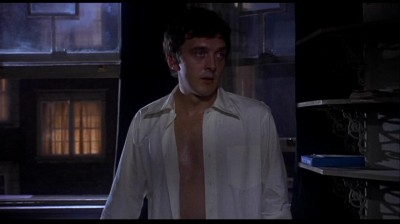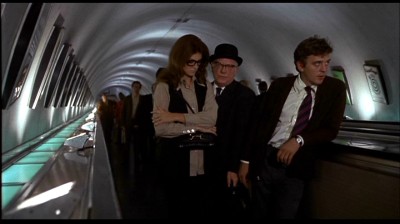Terrific, little-seen U.K. suspenser.
By Paul Mavis
I recently picked up a new Blu-ray transfer of one my favorite early 70s British thrillers, Fragment of Fear, released here in the States by Columbia Pictures in 1971 (Sony previously released a nice DVD copy through their m.o.d. line; UK outfit Powerhouse Films released a region-free Blu-ray through their Indicator series). Starring David Hemmings, Gayle Hunnicutt, Wilfrid Hyde-White, Flora Robson, Adolfo Celi, Roland Culver, Daniel Massey, Mona Washbourne, and Arthur Lowe, written by Paul Dehn and directed by Richard C. Sarafian, Fragment of Fear has a deliciously creepy tone to its deceptively simple tale of murder, espionage and madness, expertly whipped up to a paranoid froth that should satisfy fans looking for some genuine chills.
Click to order Fragment of Fear at Amazon.

Reformed drug addict Tim Brett (David Hemmings), an author who has written a book about his addiction, is visiting his Aunt Lucy Dawson (Flora Robson) in Italy, who’s staying at her regular Pompeii resort run by Signor Bardoni (Adolfo Celi). When Lucy winds up dead at one of the tourist stops, Tim is determined to find out what happened. He becomes romantically involved with Juliet Bristow (Gayle Hunnicutt), the woman who found Lucy’s body.

They return to London where Tim is immediately pressured by unseen forces to drop his investigation―or else. A typewritten warning note―later discovered to have been typed on his machine with his brand of paper―is handed to him on a train by Miss Dacey (Hilda Barry), who then files a police report that he tried to rape her…and who is then found dead. Sergeant Matthews (Derek Newark) doesn’t believe Tim’s story about laughter on Tim’s tape recorder or threatening voices over his phone, but then again…Tim soon discovers there is no Sgt. Matthews on the police force.
Is Aunt Lucy’s philanthropic “Stepping Stones” organization of reformed criminals involved in this surreptitious persecution? Or is it an Intelligence operation by Major Ricketts (Daniel Massey) and Mr. Nugent (Arthur Lowe)? Or is it simply that Tim is…quite mad?

RELATED | More 1970s film reviews
It’s impossible to discuss Fragment of Fear without revealing some of the surprises at the end of the movie, so if you haven’t seen it, stop reading, and buy the movie. Otherwise…you’ve been warned….

Fragment of Fear is one of those slip-through-the-crack titles that escapes you when you’re racking your brain for something interesting to watch, only to be rediscovered with genuine pleasure when you accidentally fall upon it in your library. Until I watch it again every few years, I always forget what an effective little shocker it is―particularly now when seen on disc in its proper aspect ratio (how did we get to love movies shown on regular television all those years ago, all cropped and edited and constantly interrupted with commercials?).

An intriguing mixture of paranoid murder mystery and espionage film (…or is it?), Fragment of Fear doesn’t break any new ground as far as its relatively simple story goes. However, it is expertly directed by Richard C. Sarafian for maximum creep-out value, where he creates a nightmarish world of red herrings and blind alleys that will stay with you long after the picture’s over. The plot itself couldn’t be simpler: former drug addict Hemmings, having recently befriended his aunt, decides to investigate her seemingly senseless murder, rapidly discovering that her life and death aren’t as simple as he previously thought. SPOILERS TO FOLLOW He’s hounded and frightened by mysterious forces, until he loses everything, including his fiancé and his mind. End of story.

Of course, we’ve seen variations on this plot countless times before, so it’s up to director Sarafian (who would follow Fragment of Fear with his best known work: the equally hallucinogenic Vanishing Point) and screenwriter Paul Dehn (Goldfinger, The Spy Who Came In From the Cold, The Deadly Affair, all the Planet of the Apes sequels) to create a believable “unbelievable” world of distrust and fear that truly grips and unnerves the audience―something that rarely happens in these kinds of movies.

They certainly succeed here. Dehn’s original screenplay is filled to overflowing with red herrings and intentional missteps and hazy clues that dislocate the viewers, keeping them guessing and second-guessing their own powers of deducing exactly what is happening. Who exactly is Adolfo Celi, and what does he have to do with Flora Robson and “The Stepping Stones” (he’s the one that throws away their funeral flowers card)? Who is Mona Washbourne to Robson, and why is she curious about whether or not Hemmings told Celi about the “X” that Robson had marked on her map…the exact spot where Robson was found murdered?

For that matter, who was Robson? Was her group of “reformed” criminals used for espionage purposes, or were they being used by British Intelligence for blackmail purposes (and why was Hemmings just getting to know her, talking to her like he met and made a new friend)? And what about Gayle Hunnicutt? It seems fairly convenient for her to suddenly become Hemmings’ fiancé, when the basis of their relationship is her having found the dead body of his aunt (Sarafian is clever in not showing us how their relationship matures, further making us suspicious of it). Could she be a control agent for British Intelligence, helping to keep Hemmings off-balance? Her implacable cool and calm would certainly seem to suggest that. But then again…what if all of this is in Hemmings’ formerly drug-addled mind?

Even better is Sarafian’s control of the increasingly threatening mise-en-scene. If you’re like me, you’ve seen literally thousands of similar scenes where someone is menaced or frightened in their empty apartment or home. That kind of scene just doesn’t hold any more surprises for me (nor for you, if you’ve seen your fair share of thrillers). Sarafian managed, however, with some rather brilliant framing (courtesy, perhaps, of master cinematographer Oswald Morris?) and a controlled use of sound, to make me actually somewhat nervous watching Hemmings quietly flip out in his apartment―and that hasn’t happened to me since I was a kid.

Who knew Sarafian, who has a reputation with some critics for being “sloppy,” could control these scenes so well, and with such impressive force? None of these effects are overt, either; they’re understated and on the perimeter, unsettling us as they accumulate quietly. When Hemmings enters the office part of his grimy, shabby apartment, a light suddenly goes out in another apartment across the courtyard. We see it, but we don’t necessarily connect it up with what is happening (…at first). When Hemmings gets off the phone with his tormentor (that scary laughter is really unnerving…and it does sound like both Hemmings and Massey), a car suddenly drives off on the soundtrack. Is it connected with what’s going on? Maybe…or maybe we’re getting just as paranoid as Hemmings). And as Hemmings searches the dark shadows of his apartment for some kind of movement, our eyes trick us into thinking we see something there, too. It’s a marvelous illustration of suggestive moviemaking.

As for Fragment of Fear‘s “non-ending” ending…well, what else did you expect? A clear answer to what previously happened? That’s not the point of Fragment of Fear. Even in the hot, sunny, bright Pompeii locations of the film’s opening, Dehn and Sarafian lets us know that reality is murky, at best, as Sarafian stages a brilliant foreshadowing shot of that dark reality to come: a swarm of flies hovering over the body’s location, blotting the brilliantly blue sky, as the tour guide sullenly ignores their significance.

Giving a concrete answer to what is happening to Hemmings would ruin all of the mystery and portents of the preceding events. To come right out and say, “Oh, he’s crazy,” or “Oh, it’s British Intelligence shutting him up,” would bring down the whole dreamy/nightmarish structure, giving pedestrian worldliness to what should remain “otherworldly,” while letting the audience off the hook: an explanation provides relief for the confused mind. I would imagine most viewers will see the final sequence on the train where Hemmings openly hallucinates, along with the final shot of him being pushed around in a wheelchair by Hunnicutt, as evidence that the whole nefarious plot was of his imagining. And they could be right.
However…those scenes could also indicate that whatever plot that was initiated against Hemmings has succeeded, just as Massey told him it would: Hemmings was marginalized right out of anyone believing him about a criminal organization used for blackmail/espionage. And those previous viewers, who were so sure about the final scenes…would be wrong. All perverse red herrings and paranoid delusions, Fragment of Fear depends on its atmosphere alone, brilliantly achieving a genuinely frightening waking nightmare world where the viewer can’t be sure of what is, or isn’t, reality. And who, in the end, wants an answer to that?

PAUL MAVIS IS AN INTERNATIONALLY PUBLISHED MOVIE AND TELEVISION HISTORIAN, A MEMBER OF THE ONLINE FILM CRITICS SOCIETY, AND THE AUTHOR OF THE ESPIONAGE FILMOGRAPHY. Click to order.
